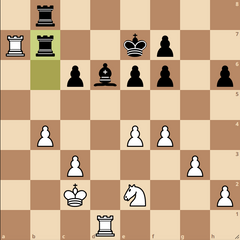Students Play the Alapin Sicilian
This week’s article will feature two games from the MCA weekly Wednesday Arena tournament, which began with a popular opening, the Alapin Sicilian. In the world of chess, the Alapin Opening has emerged as a popular choice among many players at the very top levels. We will examine how chess enthusiasts can employ the Alapin Opening in their games, highlighting its unique appeal and effectiveness and also how to fight against it. Whether you're a seasoned player or a novice, the Alapin can enrich your understanding of chess as a whole.
The Strength of the Alapin
This game featured two MCA students, Eli and Will, who took 4th and 1st respectively in the MCA Wednesday Arena. Eli had White and opted for the Alapin and quickly gained a significant advantage when Will wasn’t able to navigate the theory correctly. Check out the annotated game (Eli vs Will) to see if he was able to convert his edge.
Some key takeaways from the game:
- In the opening, priority #1 is to fight for the center and to develop your pieces in a way that they will be happy for the rest of the game.
- Attacking your opponent’s pieces is useless if you’re just forcing them to do something they wanted to do anyways.
- Always be on the lookout for tactics. They can arise in all types of boring-looking positions.
- When trying to convert a material advantage, trades are helpful, but only if you are trading for a piece that is at least as active as yours… see comments to move 18
- On the other hand, when you are down material or have a worse position, it’s okay to trade pieces, but you have to do it in a way that creates some imbalance in the position. Will did this by trading into a position where he had the bishop pair for example.
Test Your Knowledge
Try to solve these positions and then check out the answers in the annotated game.

White has just placed both of his pawns on the “dream” squares. How should Black respond?

Tactics can seemingly come out of nowhere. Is this one of those cases, or is a normal move best?
The Weakness of the Alapin
Again, this game was played between two MCA students in the MCA Wednesday Arena, and again, it was an Alapin Sicilian. In the last game, Black reacted poorly but went on to win. Here Olivia showed that she was well prepared, and played one of the best moves against the Alapin. Check out the annotated game (Pratham vs Olivia).
Some key takeaways from the game:
- You always have to look for your opponent’s threats. Then once you identify a threat, you have to decide whether it’s worth responding to or not. Then, and only then should you make your move.
- Keeping tension on your opponent’s center is almost always better than relieving that tension, because it makes their game much more difficult and cramped.
- Having a bad opening doesn’t mean you will lose the game: In both of these examples, the one who was worse out of the opening went on to win the game, so never stop fighting when you’re at the board.
- Even when you play with sidelines such as the Alapin, it might seem like you’re avoiding opening theory, but as we see here, almost always you will transpose to a structure from one of 4 main opening setups, the e4-e5 structures, the French structure, Sicilian Structure, or the QGD structure, so it’s very important to master these.
Test Your Knowledge
Try to solve these positions and then check out the answers in the annotated game.

Black has won the bishop pair, but White has a stronger center. How should Black put pressure?

White just made a move. What are they threatening and how should you react?
Never Surrender
In both of the featured games, the player that was somewhat worse out of the opening went on to win the game. Anything can happen in a chess game and you should never give up just because you lose some material or have an uncomfortable position. In the first game, Will actively fought back to reach a drawable position and then capitalized on Eli’s mistake in time trouble. If you would like to learn more about how to fight back in chess, you might enjoy our “Never Surrender” online summer camp. In the camp, you can see how Carlsen, Giri, Kasparov and other top players never give in easily. They always fight to the finish!
About This Series
 |
Our new series is written by International Master (IM) Sandeep Sethuraman and will feature analysis of tournament games played by our students. Sandeep is a rising high school senior in Arizona and one of the top players in the USA for his age. Students are encouraged to submit games for future articles by contacting our online team. |




Leave a comment